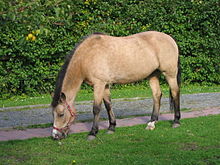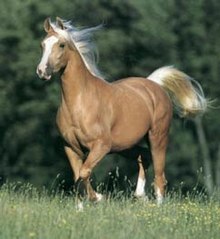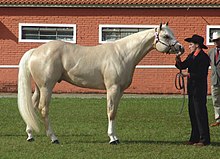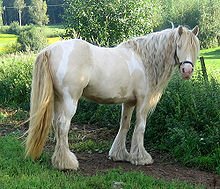Cream gene of the horse

The cream gene ( Cr ) is a gene that causes a lightening of the horse's coat and is therefore listed as a dilute gene .
The lightening of the coat depends on whether only one or two Cream genes are inherited. It also depends on the initial color (chestnut, bay or black) and is different from horse to horse. With the starting colors, the lightening of the fur and the effect on the eye color of the animals are listed in a table.
Lightening in the fox
| Fox | crcr | red fur | red or lighter colored long hair | Brown eyes |
| Isabell | Crcr | yellowish fur | cream or white mane | light brown eyes |
| Weißisabell or Cremello | CrCr | whitish fur | snow-white mane | light blue eyes |
Isabell
Foxes that are simply lightened by a cream gene are called Isabell or Goldisabell ( Palomino in English ). Foxes that are doubly lightened by two cream genes are called white sable or cremello. For the origin of the name, see Isabel color .
Foxes with this gene can be born as almost white foals, which later darken a little. But they can also take on all shades from a very light sand color to normal fox-colored top hair.
Horses with darker fur and light mane are usually not Isabelles, but rather light foxes . Their long hair is lightened by the flax gene, while the top hair remains unchanged. The most well-known examples of light foxes are Haflingers and black forests for dark and light foxes .
In ancient Greece, light-colored horses with white manes were considered sacred. It is not known whether these were Isabels or fox falcons with flaxes.
Races
In the United States, palominos are bred for their color and are listed as a breed by two breeding associations. The color is decisive for the entry , less the exterior , the basic gaits or the free jumping . American Quarter Horses are predominantly (approx. 97%) used for Palomino breeding .
In Great Britain, however, there is a palomino breeding tradition of the British Palomino Society , which is based on the British pony breeds and warmblood horses, English hunters .
When Kinsky horse are Isabella and earth-colored horse breeding goal.
Possible confusion
- Darker palominos can look the same or very similar to foxes with flaxes or like brown wind-colored horses.
- Classic Champagne: Horses of this color differ from the lighter palominos by their pink skin with dark spots.
- Foxes lightened by Pearl differ from Isabelles in that their long hair is the same color as the rest of the fur.
Lightening when tanning

| Brown | crcr | red, brown fur | black long hair | Brown eyes |
| Buckskin , earth colors | Crcr | yellowish fur, black legs | black mane | brown or light brown eyes |
| Perlino | CrCr | almost white fur, legs darker | slightly darker, yellowish, almost white mane | light blue eyes |
Earth colors
The color of genetically earth-colored horses (Buckskin) varies from a light fawn, which can easily be confused with that of a real dun , to a coat color that is indistinguishable from that of a real bay . The tail, mane and legs are usually black. The wild color badges that are known from real Fallows ( eel line , shoulder cross , zebra stripes on the legs) are usually missing.
Possible confusion
- Dark earth tones often look like normal browns .
- The dun is distinguished by the eel line and its often two-colored mane
- Brightening the brown with pearl
- Amber Champagne: Horses of this color differ from the earth-colored by their monochrome, chocolate-brown mane and tail and pink skin with dark spots.
Lightening when rapping
| Black | crcr | black fur | black long hair | Brown eyes |
| Illuminated bustard, earth brown | Crcr | grey fur | gray mane | brown or light brown eyes |
| Smoky Cream | CrCr | whitish fur | white mane | light blue eyes |
Illuminated bustard, earth brown
The color of black, which is simply lightened by the cream gene, can vary greatly; it is called Smoky Black in English. The darker variants can look like light black horses and only attract attention through their lighter eyes. They are called luminous bustards. Lighter animals appear like dark foxes and are called earth browns .
Double cream gene: Cremello, Perlino, Smoky Cream
Horses lightened by a double cream gene appear almost white with pink skin. However, they are not absolutely white, but their white has a slightly golden shimmer in the white isabell (Cremello) and a slightly gray tinge in the smoky cream.
The eyes are blue. If the eyes are so much brightened by a form of albinism (here OCA4, MATP gene), it can be assumed that the affected animals can see much more poorly than their normal-colored conspecifics and are more dazzled by bright sunlight. However, this handicap seems to be so limited that people do not recognize it from the horse's behavior.
American Creme Horse
The American Creme Horse was born in 1937 in Nebraska , USA thanks to the efforts of Caleb and Hudson Thompson . A stallion named Old King was chosen as the progenitor . Old King was a cross between Arab and Morgan and a white born horse. Since the stallion Old King passed on his rare color well, the Thompsons came up with the idea of developing a breed of white-born horses. Since all horses born white could be registered, individual animals could also carry the gene for dominant white color . However, the American Creme Horse is not actually a breed; the conformation still varies a lot, and the influences of thoroughbred Arabian , Quarter Horse , Morgan and English thoroughbred can be seen in the individual horses. The eyes are usually light blue, which is called fish eyes , or light brown, rarely dark brown. The passages are often flat and soft. The American Creme Horse is considered intelligent and willing to learn and is therefore often used in the circus, at shows or at parades. Its pleasant temperament makes it a suitable leisure horse. Such white-born horses used to be popular with kings and princes.
Possible confusion
- Older molds often have completely white fur, but can be recognized by their dark skin.
- Horses of dominant white color have completely white fur, pink skin, and light brown or blue eyes.
- Maximum piebalds look like dominant white horses, but can have different eye colors (including blue).
- Double lightened by Champagne The pink skin has dark spots, the almost white fur of the double lightened fox has a golden shimmer. The fur is usually darker than that of a cremellos, more like lighter Isabelles or earth-colored ones.
Genetics: Oculocutaneous albinism type 4
The cream gene is located on chromosome 21 of the horse. It is a mutation of the MATP gene and therefore corresponds to oculocutaneous albinism type 4 (OCA4) in humans. The notation for the cream gene is "Cr", if it is missing "cr". The cream gene brightens both red and black color pigments and can therefore change all basic colors of the coat. Both the short hair and the long hair are lightened to different degrees from silver to white. This effect is stronger with the red basic color of the fox than with a black fur . In addition, the cream gene has an influence on the eye color of the respective horse. The cream gene is inherited as an intermediate , i.e. an existing cream gene is always externally visible. In contrast, albinism is inherited in a dominant recessive manner .
Without the cream gene, the basic color is not lightened; the absence of the cream gene is noted by two small crcr . If only one cream gene is inherited, the lightening is only moderate; this is indicated by a large and a small Crcr . With two inherited Cream genes, on the other hand, marked as CrCr , the horse can look almost white. It always has blue eyes. A double lightened fox is called Cremello and with foxes without a cream gene only results in Isalbell foals. Perlino is the name given to a double-lightened bay which, with bay without cream gene, only produces foals with a cream gene (earth-colored or Isabell).
Oculocutaneous albinism type 1, in which no residual tyrosinase function is retained, does not occur in horses. Therefore, it is believed that this mutation would be lethal (fatal).
See also
literature
- Sidney David Markman: Horse in Greek Art (= Johns Hopkins University studies in Archeology. 35). The Johns Hopkins Press, Baltimore MD 1943 (Reprinted by Biblo & Tannen Booksellers & Publishers Incorporated, New York NY 1969, ISBN 0-8196-0247-7 ).
- S. Adalsteinsson: A new interpretation of the inheritance of the horse colors dun and Isabella in a Russian stud during the period 1854-1894. In: The Journal of Heredity. 69, 6, 1978, ISSN 0022-1503 , pp. 426-428.
Individual evidence
- ↑ Denis Mariat, Sead Taourit, Gérard Guérin: A mutation in the MATP gene causes the cream coat color in the horse. In: Genet. Sel. Evol. 35 (2003), pp. 119-133. PMID 12605854
- ↑ MM Locke, LS Ruth, LV Millon, MC Penedo, JD Murray, AT Bowling: The cream dilution gene, responsible for the palomino and buckskin coat colors, maps to horse chromosome 21. In: Anim Genet. 32 (6), 2001 Dec, pp. 340-343. PMID 11736803
- ↑ Krista Siebel: Analysis of genetic variants of loci for the coat color and their relationship to the color phenotype and to quantitative performance characteristics in pigs . Inaugural dissertation . Institute for Animal Science at the Humboldt University in Berlin. July 2001.








